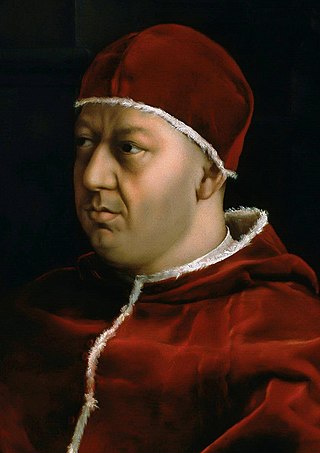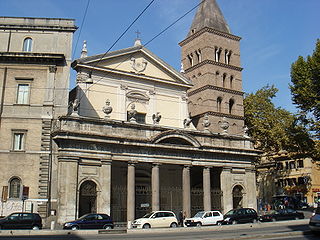Related Research Articles

Pope Urban VII, born Giovanni Battista Castagna, was head of the Catholic Church, and ruler of the Papal States from 15 to 27 September 1590. His thirteen-day papacy was the shortest in history, during which a smoking ban encompassing churches across the world was implemented.

Pope Leo X was head of the Catholic Church and ruler of the Papal States from 9 March 1513 to his death in December 1521.

Domenico Grimani was an Italian nobleman, theologian and cardinal. Like most noble churchman of his era Grimani was an ecclesiastical pluralist, holding numerous posts and benefices. Desiderius Erasmus dedicated to Grimani his Musica.

Raffaele Sansoni Galeoti Riario was an Italian Cardinal of the Renaissance, mainly known as the constructor of the Palazzo della Cancelleria and the person who invited Michelangelo to Rome. He was a patron of the arts. He was also the first adolescent to be elevated in the College of Cardinals in the history of the Holy See.

The Basilica of Sts. Vitalis, Valeris, Gervase and Protase is an ancient Catholic church in Rome, and is both a minor basilica and a titular cardinalatial title. It is commonly called the Basilica di San Vitale.

The Basilica of Saint Sylvester the First, also known as, is a Roman Catholic minor basilica and titular church in Rome dedicated to Pope Sylvester I. It is located on the Piazza San Silvestro, at the corner of Via del Gambero and the Via della Mercede, and stands adjacent to the central Post Office.

San Crisogono is a church in Rome dedicated to the martyr Saint Chrysogonus. It was one of the tituli, the first parish churches of Rome, and was probably built in the 4th century under Pope Sylvester I (314–335).
Francesco di Tommaso Soderini was a major diplomatic and Church figure of Renaissance Italy, and brother of Piero Soderini. He was an adversary of the Medici family.

Francesco Armellini Pantalassi de' Medici was a cardinal of the Roman Catholic Church. He was a member of the Roman Curia.

Francesco Gonzaga was an Italian bishop and a Cardinal of the Roman Catholic Church during the reigns of Popes Pius II, Paul II and Sixtus IV.

Pope Leo X created 42 new cardinals in eight consistories.
Giovanni Conti (1414–1493) was an Italian Roman Catholic bishop and cardinal.

Marco Cornaro was an Italian Roman Catholic cardinal and bishop.

Antonio Maria Ciocchi del Monte was an Italian Roman Catholic bishop and cardinal.

Achille Grassi was an Italian Roman Catholic bishop and cardinal.
Esteban Gabriel Merino was a Spanish Roman Catholic bishop and cardinal.

Giovanni Ricci was an Italian Roman Catholic bishop and cardinal.
Luigi Cornaro was an Italian Roman Catholic cardinal and bishop.
Marcantonio Maffei was an Italian Roman Catholic bishop and cardinal.

Girolamo Farnese (1599–1668) was a Roman Catholic cardinal.
References
- 1 2 3 4 Miranda, Salvador. "CONTI, Francesco (ca. 1470-1521)". The Cardinals of the Holy Roman Church. Florida International University. OCLC 53276621.
- 1 2 3 Cheney, David M. "Francesco Cardinal Conti †". Catholic-Hierarchy.org . Retrieved February 14, 2019. [self-published]